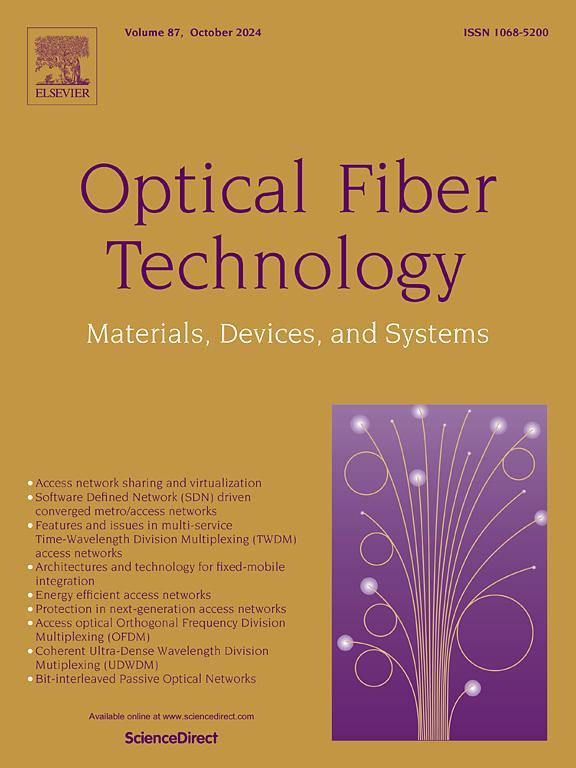基于CNN的WDM CO-OFDM系统信道内非线性均衡方法
IF 2.7
3区 计算机科学
Q2 ENGINEERING, ELECTRICAL & ELECTRONIC
引用次数: 0
摘要
波分复用波分复用相干光正交频分复用(PDM-WDM CO-OFDM)系统由于其高频谱效率和抗频率选择性衰落能力而成为光通信领域的一项关键技术。然而,在长距离或高数据速率传输场景下,光纤非线性效应引起的信号失真会显著降低系统性能。传统的非线性补偿方法,如高阶Volterra系列,可以解决其中的一些挑战,但受限于高计算复杂度和精度不足,使其不适合实时传输要求。为了解决这些挑战,我们提出了一种基于卷积神经网络(CNN)的非线性均衡方法。通过引入滑动窗口机制,将全局信号分割为局部信号片段,使模型能够有效捕获局部非线性特征,同时保持较低的计算复杂度。此外,cnn利用参数共享和并行计算来显著提高训练和推理速度,克服了递归神经网络(例如Bi-LSTM)在处理时间序列数据时的计算效率低下和顺序性。仿真结果表明,对于数据速率为850 Gb/s的16 qam调制PDM-WDM CO-OFDM系统,该方法比Volterra系列模型的最大传输距离提高了100%。此外,在获得与Bi-LSTM模型相当的误码率(BER)性能的同时,基于cnn的方法的计算复杂度显著降低。该方法具有较好的鲁棒性和非线性均衡性能。本文章由计算机程序翻译,如有差异,请以英文原文为准。
CNN based intra channel nonlinear equalization method for WDM CO-OFDM systems
Polarization-division multiplexing wavelength-division multiplexing coherent optical orthogonal frequency-division multiplexing (PDM-WDM CO-OFDM) systems have emerged as a key technology in optical communications due to their high spectral efficiency and ability to resist frequency selective fading. However, in long-distance or high-data-rate transmission scenarios, signal distortion caused by fiber nonlinear effects significantly degrades system performance. Traditional nonlinear compensation methods, such as the high-order Volterra series, can address some of these challenges but are limited by high computational complexity and insufficient accuracy, making them unsuitable for real-time transmission requirements. To address these challenges, we propose a convolutional neural network (CNN)-based nonlinear equalization method. By introducing a sliding window mechanism, the global signal is divided into local segments, enabling the model to efficiently capture local nonlinear features while maintaining low computational complexity. Additionally, CNNs leverage parameter sharing and parallel computation to significantly improve training and inference speeds, overcoming the computational inefficiencies and sequential nature of recurrent neural networks (e.g., Bi-LSTM) in handling time-series data. Simulation results demonstrate that, for a 16-QAM modulated PDM-WDM CO-OFDM system with a data rate of 850 Gb/s, the proposed method improves the maximum transmission distance by 100 % compared to the Volterra series model. Furthermore, while achieving comparable bit error rate (BER) performance to the Bi-LSTM model, the computational complexity of the CNN-based method is significantly decreased. The proposed CNN method exhibits superior robustness and performance in nonlinear equalization.
求助全文
通过发布文献求助,成功后即可免费获取论文全文。
去求助
来源期刊

Optical Fiber Technology
工程技术-电信学
CiteScore
4.80
自引率
11.10%
发文量
327
审稿时长
63 days
期刊介绍:
Innovations in optical fiber technology are revolutionizing world communications. Newly developed fiber amplifiers allow for direct transmission of high-speed signals over transcontinental distances without the need for electronic regeneration. Optical fibers find new applications in data processing. The impact of fiber materials, devices, and systems on communications in the coming decades will create an abundance of primary literature and the need for up-to-date reviews.
Optical Fiber Technology: Materials, Devices, and Systems is a new cutting-edge journal designed to fill a need in this rapidly evolving field for speedy publication of regular length papers. Both theoretical and experimental papers on fiber materials, devices, and system performance evaluation and measurements are eligible, with emphasis on practical applications.
 求助内容:
求助内容: 应助结果提醒方式:
应助结果提醒方式:


